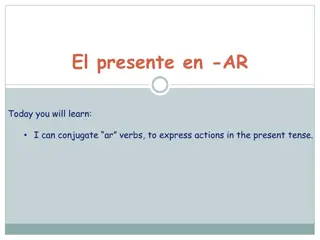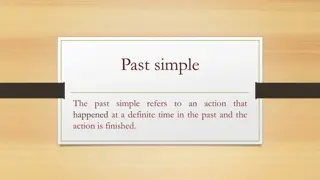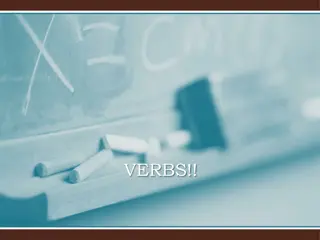Mastering 1-Syllable Slender Verbs in Irish Past Tense
Learn the rules for forming the past tense of 1-syllable slender verbs in Irish, including adding a s.imhi (h) after the first letter, using Ar to ask questions, and N or to form negatives. Practice with examples and easy-to-follow instructions for each verb type.
Download Presentation

Please find below an Image/Link to download the presentation.
The content on the website is provided AS IS for your information and personal use only. It may not be sold, licensed, or shared on other websites without obtaining consent from the author.If you encounter any issues during the download, it is possible that the publisher has removed the file from their server.
You are allowed to download the files provided on this website for personal or commercial use, subject to the condition that they are used lawfully. All files are the property of their respective owners.
The content on the website is provided AS IS for your information and personal use only. It may not be sold, licensed, or shared on other websites without obtaining consent from the author.
E N D
Presentation Transcript
Gramadach cuid a tr
An Aimsir Chaite Inn (The Past Tense - Yesterday) 1 syllable slender verbs If a verb in the past tense begins with a consonant, a h (known as a s imhi ) is inserted after the first letter. We never use a s imhi for verbs that begin with l, n and r. For example: Br s takes a s imhi (h) in the past tense. The s imhi (h) is inserted after the first letter. Br s becomes B r s m The only difficult part is when we want to say we did something in the past tense. With slender verbs in the past tense, we add eamar onto the end of the stem along with putting the s imhi after the first letter. s imhi (h) + we(eamar) Br s
An Aimsir Chaite Inn (The Past Tense - Yesterday) 1 syllable slender verbs If a verb in the past tense begins with a vowel, we put a D in front of the first letter. For example: ist would become D ist in the past tense. The only difficult part is when we want to say we did something in the past tense. With slender verbs in the past tense, we add eamar onto the end of the stem along with putting D in front of the first letter. D + we(eamar) ist
An Aimsir Chaite Inn (The Past Tense - Yesterday) 1 syllable slender verbs D in front of and a s imhi (h) after the first letter. If a verb in the past tense begins with an F, we put a For example: F g would become in the past tense. fill The only difficult part is when we want to say we did something in the past tense. With broad verbs that begin with f in the past tense, we add amar onto the end of the stem along with putting a D in front of and a h after the first letter. + we(amar) D + h fill
An Aimsir Chaite Inn (The Past Tense - Yesterday) 1 syllable slender verbs Ceisteach agus Di ltach (Questions and Negative) To ask a question in the past tense, we put Ar before the verb e.g. Ar bhr s t ? (Did you break?), Ar rith t ? (Did you run?), Ar eist t ? (Did you listen?)* To say that you didn t do something, we put N or before the word e.g. N or bhr s m (I did not break), N or fill m (I did not return), N or ist m ? (I did not listen)* *Notice how we don t use d when using the ceisteach agus di ltach
An Aimsir Chaite Inn (The Past Tense - Yesterday) 1 syllable slender verbs Quick Recap: 1. For verbs that begin with a consonant, add a h after the first letter e.g. br s= bhr s m 2. For verbs that being with a vowel, put a d in front of the word e.g. ist= d ist m 3. For verbs that begin with an f, put a d in front of the first letter and a h after it e.g. fill = d fhill m 4. For verbs that begin with l, n and r, no change is made in the past tense e.g. rith = rith m 5. To ask a question, we use Ar. To say the negative, we use N or.























